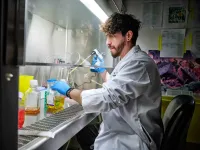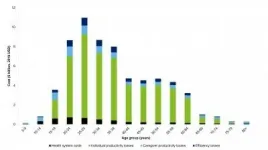(Press-News.org) DALLAS, March 3, 2021 -- American Indian people with atrial fibrillation (AFib) had the highest risk of non-hemorrhagic stroke when compared with people in other racial and ethnic groups, and they also experienced the highest overall risk for stroke even without atrial fibrillation (AFib), according to new research published today in the Journal of the American Heart Association, an open access journal of the American Heart Association.
"In previous research, we have confirmed that American Indian individuals, when compared with those in other racial or ethnic groups, have the highest risk of atrial fibrillation, which is a quivering or irregular heartbeat that can substantially increase the risk of blood clots and stroke," said lead study author Gregory M. Marcus, M.D., M.A.S., a cardiologist, professor of medicine and associate chief of cardiology for research at the University of California, San Francisco. "While American Indian people are known to have a particularly high risk for stroke in general, the relationship between AFib and non-hemorrhagic, or non-bleeding, stroke among this group has not been thoroughly studied."
In this study, researchers reviewed medical records for nearly 17 million adults (ages 18 or older) who were treated in hospitals or ambulatory care settings throughout the state of California between January 1, 2005 and December 31, 2011 and followed for a median of 4.1 years. About 0.6% of the patients were of American Indian descent; 56.7% were non-Hispanic white people; 25.9% were Hispanic people; 8.7% were of Asian descent; and 8.1% were Black people. During the four years of follow-up, there were 166,826 non-hemorrhagic strokes, of which, 36,950 strokes occurred among patients with atrial fibrillation.
As a group, American Indian people experienced the highest rates of non-hemorrhagic stroke whether compared to people in all the other racial and ethnic groups in the study combined, or when compared individually to each racial and ethnic group. Among the specific findings:
American Indian people had a 47% higher risk of non-hemorrhagic stroke when compared with all the people in all of the other racial and ethnic groups;
American Indian people with AFib had a 38% higher risk of stroke when compared with people in the other population groups who also had AFib;
Atrial fibrillation alone could not explain the elevated risk: American Indian adults without AFib had a 59% higher risk of stroke compared with adults in the other racial and ethnic groups without AFib; and
Overall, American Indian adults had higher rates of Type 2 diabetes, obesity and smoking, which are known risk factors for stroke. American Indian people also had lower rates of health insurance coverage and lower income levels.
"The results of our study add to the growing body of evidence that race and ethnicity are important factors when assessing stroke risk," Marcus said. "However, our findings that conventional risk factors such as AFib may not be the cause for this increased risk among American Indian individuals, suggest other influences are in play. These could possibly be related to hereditary factors, environmental exposures or disparities in access to healthcare, and this clearly warrants further attention."
The study's findings are observational, and while a large group of adults were analyzed, only people receiving treatment in California were included in the analysis. Marcus said the next step is to expand on these findings, such as conducting randomized trials among American Indian populations, to determine the most effective ways to save lives.
"American Indian people experience the highest rates of stroke in our society. Together, regular preventive care that includes routine screening and treatment for hypertension and Type 2 diabetes, along with regular follow-up that may detect other conditions such as atrial fibrillation, accompanied by guideline-directed care could help mitigate this heightened risk for stroke, which is largely preventable," Marcus said. "And, then there remains the challenge of determining optimal methods to actually implement these strategies in the real world that can improve people's health and lives."
This study's focus and findings reinforce the American Heart Association's November 2020 Presidential Advisory, "Call to Action: Structural Racism as a Fundamental Driver of Health Disparities." The advisory declared structural racism as a major cause for poor health and premature death from heart disease and stroke for many and detailed the Association's immediate and ongoing action to accelerate social equity and health care and outcomes for all people.
INFORMATION:
Co-authors are José M. Sanchez, M.D.; Stacey E. Jolly, M.D., M.A.S.; Thomas A. Dewland, M.D.; Zian H. Tseng, M.D., M.A.S.; Gregory Nah, M.A.; and Eric Vittinghoff, Ph.D., M.P.H. Authors' disclosures are in the abstract. The database used was funded by the U.S. Department of Health and Human Services' Agency for Healthcare Research and Quality. The researchers reported no additional funding for this study.
Additional Resources:
Multimedia is available on the right column of release link:
https://newsroom.heart.org/news/stroke-risk-highest-among-american-indian-people-with-or-without-afib?preview=ae387e701f18c7675a1cdbd4f96ed336
After March 3, view the manuscript online.
American Indians may have a higher risk for irregular heartbeat
Who is at risk for AFib?
Cardiovascular Health in American Indians and Alaska Natives: A Scientific Statement From the American Heart Association
Follow AHA/ASA news on Twitter @HeartNews
Follow news from the Journal of the American Heart Association @JAHA_AHA
Statements and conclusions of studies published in the American Heart Association's scientific journals are solely those of the study authors and do not necessarily reflect the Association's policy or position. The Association makes no representation or guarantee as to their accuracy or reliability. The Association receives funding primarily from individuals; foundations and corporations (including pharmaceutical, device manufacturers and other companies) also make donations and fund specific Association programs and events. The Association has strict policies to prevent these relationships from influencing the science content. Revenues from pharmaceutical and biotech companies, device manufacturers and health insurance providers are available here, and the Association's overall financial information is available here.
About the American Heart Association
The American Heart Association is a relentless force for a world of longer, healthier lives. We are dedicated to ensuring equitable health in all communities. Through collaboration with numerous organizations, and powered by millions of volunteers, we fund innovative research, advocate for the public's health and share lifesaving resources. The Dallas-based organization has been a leading source of health information for nearly a century. Connect with us on heart.org, Facebook, Twitter or by calling 1-800-AHA-USA1.
DALLAS, March 3, 2021 -- The association between race and ethnicity and specific characteristics of some U.S. counties may have a significant impact on death rates related to cardiovascular disease, according to new research published today in the Journal of the American Heart Association, an open access journal of the American Heart Association.
Cardiovascular disease is the leading cause of death in the U.S. across all racial and ethnic groups, and disparities in cardiovascular outcomes for racial and ethnic minority groups have been documented extensively. This study presents a detailed analysis of county-level predictors of cardiovascular ...
The first proof of the origin of malignant rhabdoid tumour (MRT), a rare childhood cancer, has been discovered by researchers at the Wellcome Sanger Institute, the Princess Máxima Center for Pediatric Oncology in the Netherlands, and their collaborators.
The study, published today (3 March 2021) in Nature Communications, found that MRT arises from developmental cells in the neural crest* whose maturation is blocked by a genetic defect. The team also identified two drugs that could be used to overcome this block and resume normal development, bringing hope of new treatments for the disease.
Malignant rhabdoid tumour (MRT) is a rare soft tissue cancer that predominantly affects infants. ...
A robotics platform designed by Toronto researchers to screen thousands of COVID-19 samples at once has the potential to revolutionize how labs track the spread of viruses and other pathogens, according to new findings.
The END ...
Wild pigs are often maligned as ecosystem destroyers, but a University of Queensland study has found they also cultivate biodiverse rainforests in their native habitats.
Dr Matthew Luskin has been researching the effect of native pigs in Malaysian rainforests and found their nests may be critical to maintaining diverse and balanced tree communities.
"We've shown that wild pigs can support higher diversity ecosystems and are not just nuisances and pests, thanks to a beneficial effect of their nesting practices," Dr Luskin said.
"Prior to giving birth, pigs build birthing nests made up of hundreds of tree seedlings, usually on flat, dry sites in the forest.
"As they build their nests, the pigs ...
Researchers from the Icahn School of Medicine at Mount Sinai have identified a drug that works against depression by a completely different mechanism than existing treatments.
Their study showed that ezogabine (also known as retigabine), a drug that opens KCNQ2/3 type of potassium channels in the brain, is associated with significant improvements in depressive symptoms and anhedonia in patients with depression. Anhedonia is the reduced ability to experience pleasure or lack of reactivity to pleasurable stimuli; it is a core symptom of depression and associated with worse outcomes, poor response to antidepressant medication, and increased risk of suicide.
Ezogabine was ...
In an analysis of nationwide data from the Veterans Health Administration, approximately one-quarter of individuals with kidney stones had a diagnosis of osteoporosis or bone fracture around the time of their kidney stone diagnosis. The findings are published in the Journal of Bone and Mineral Research.
Investigators identified 531,431 patients with kidney stone disease between 2007 and 2015, and they found that 23.6% of patients had a diagnosis of osteoporosis or fracture around the time of their kidney stone diagnosis. In patients with no prior history of osteoporosis or bone analyses before their kidney stone diagnosis, 9.1% ...
Patients with dementia may benefit from being referred to specialist palliative care--a branch of medicine that focuses on optimizing quality of life and providing relief from symptoms--but who should be referred, and when? A recent analysis of published studies on the topic found a lack of consensus regarding referral criteria for palliative care in patients with dementia. The results are published in the Journal of the American Geriatrics Society.
The analysis identified a wide array of reasons for referring patients with dementia to specialist palliative care, broadly classified under 13 themes. The ...
Individuals with cancer face a higher risk of suicide than people in the general population, but little is known about the characteristics of patients with cancer who have died by suicide. A new study published in Psycho-Oncology compared the characteristics of suicide cases with and without cancer.
Among 14,446 suicide cases between 2003 and 2017 in Hong Kong, 10% had a history of cancer. Compared with non-cancer cases, patients with cancer were generally older and less likely to live alone; more likely to use violent methods; less likely to have histories of physical and psychiatric problems; and more likely to communicate about their suicidal intent before death.
"Patients with cancer ...
The impact of eating disorders in the United States was nearly $400 billion in 2018-19 when considering both economic costs and reduced wellbeing, according to a study published in the International Journal of Eating Disorders.
Investigators estimated that the total economic cost associated with eating disorders in 2018-19 was $64.7billion, equivalent to $11,808 per affected person, and the substantial reduction in wellbeing associated with eating disorders was valued at $326.5 billion.
"Our study lays bare the devastating economic impact that eating disorders have in the United States, a country where the majority of people affected suffer alone and never receive ...
Students have diverse reasons for dropping out of colleges and universities without obtaining a degree. A new study published in the European Journal of Education provides a detailed analysis of these reasons.
The study found that the most important reasons for leaving university without a degree are mainly related to students' lack of interest in their field of study, as well as wrong expectations concerning the content of their studies. Problems related to students' academic performance also appear to be important.
The study suggests potential counter measures that higher education institutions might use to help students at risk of dropping out as they strive to finish their ...



